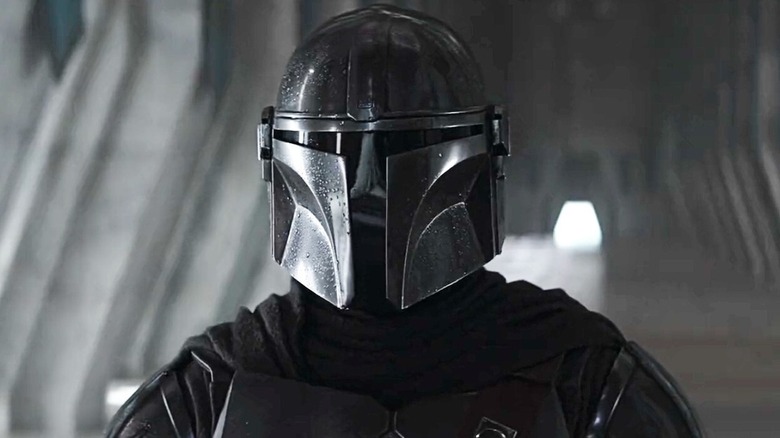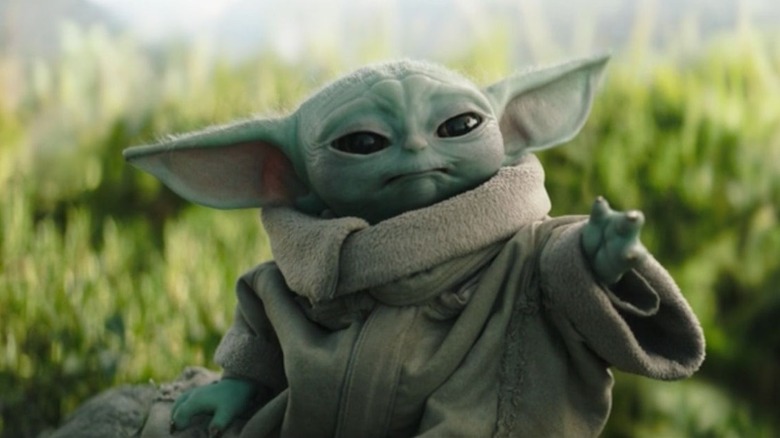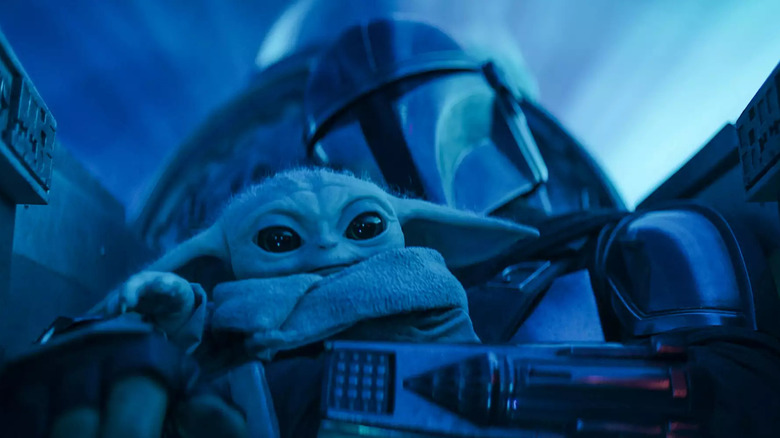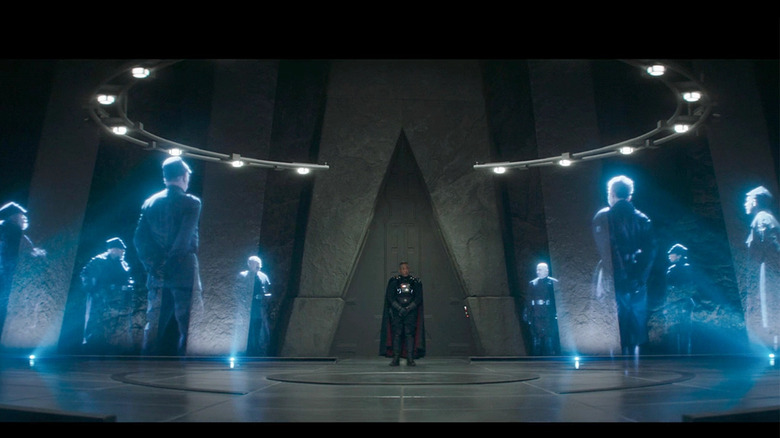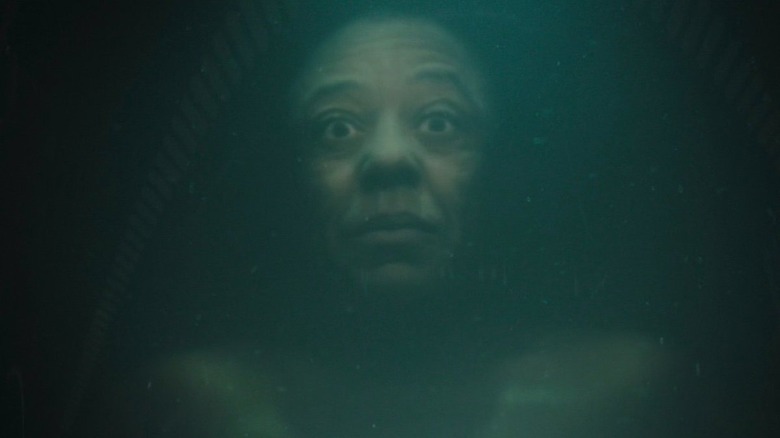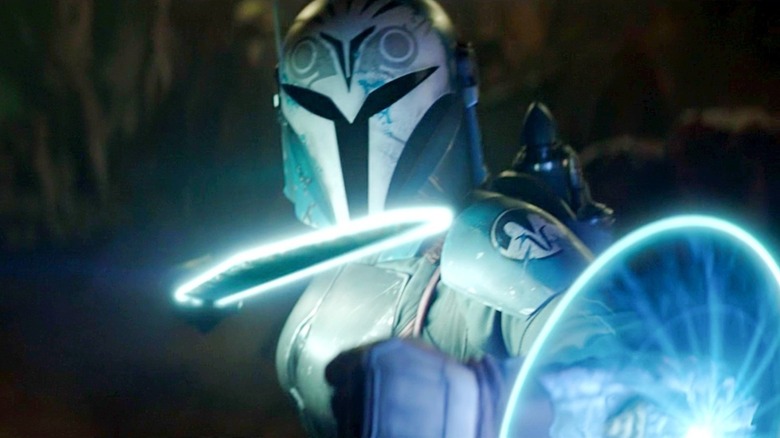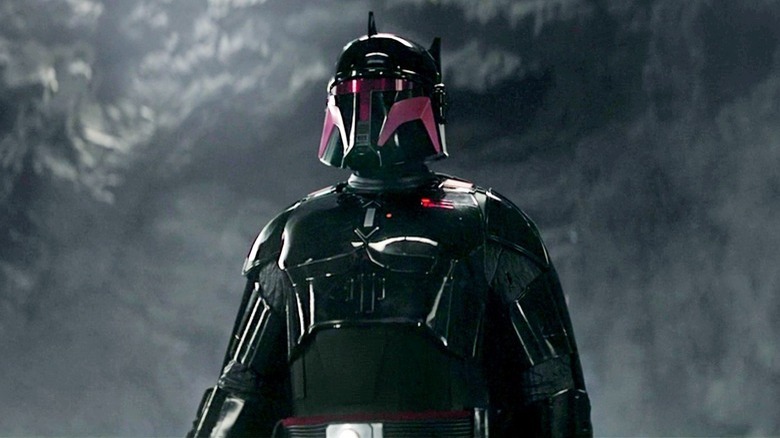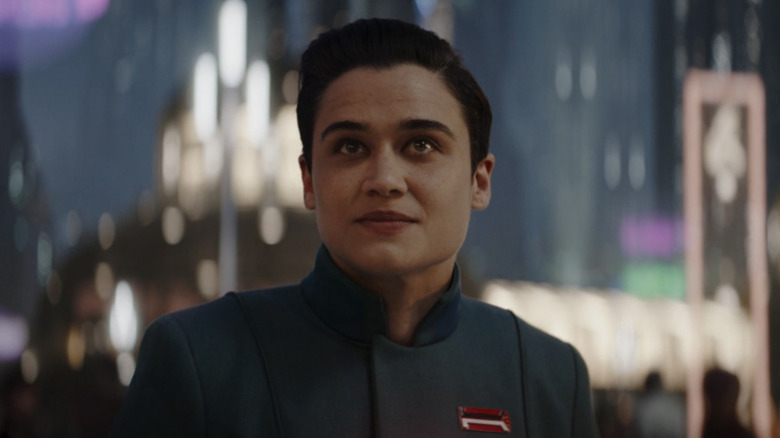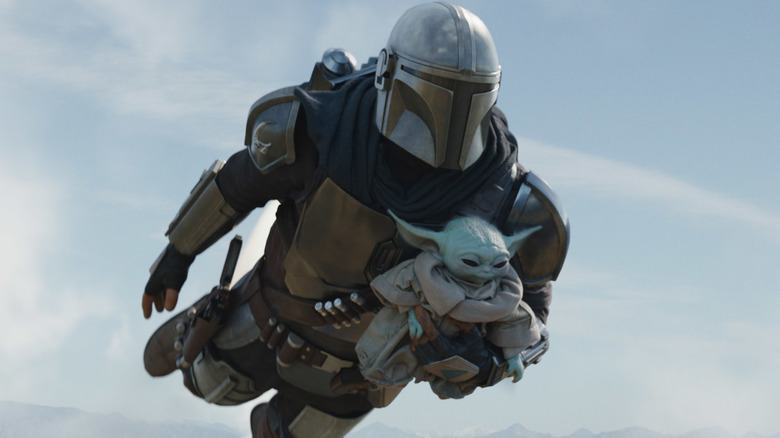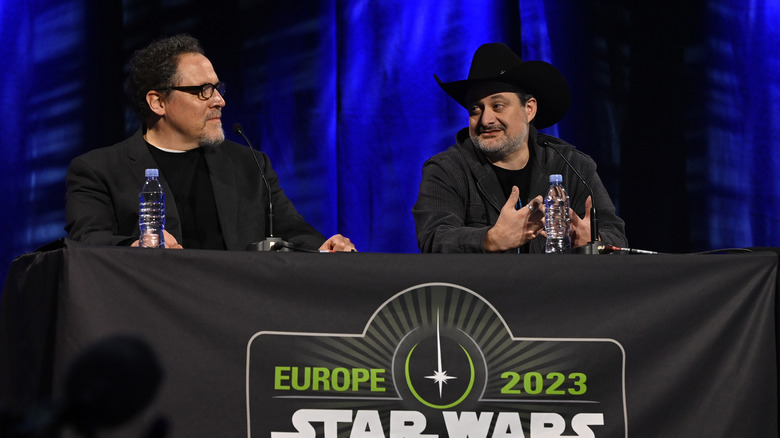Biggest Unanswered Questions In The Mandalorian Season 3
Season 3 of "The Mandalorian" ends in a surprisingly definitive fashion. With Mandalore now reclaimed by Bo-Katan (Katee Sackhoff) and the united Mandalorian tribes, a conflict that started in "Star Wars: The Clone Wars" is seemingly resolved. Din Djarin (Pedro Pascal) can finally retire to the countryside to raise Grogu to walk the way, while apparently still going on bounty hunting adventures. All is seemingly well.
But that doesn't mean there isn't room for more. In fact, Jon Favreau has confirmed that Season 4 is already written. There will be more adventures on this show, but right now, in the wake of Season 3's epic finale, all fans have are questions. Some are unanswered queries from earlier in the season, while others are inspired by the events of the final few episodes. Which character is going to be the star of the show going forward? Both Din and Bo-Katan can lay claim to the title of the Mandalorian, after all. Is the Darksaber really gone? What's going on with Project Necromancer? These are just a few of the unanswered questions "The Mandalorian" Season 3 leaves in its wake — and we're here to examine them all.
How much Jedi training did Grogu get with Luke?
Grogu takes a backseat (literally) to the main plot threads of "The Mandalorian" Season 3. For as much he remains the emotional core of Mando's character, this slate of episodes is more concerned with the Mandalorians' quest to take back their home. As a result, one big question that this season never answers emerges: Just how much time did Grogu spend training with Luke? While his Force powers are still clearly undeveloped, the feats the little guy pulls off in the season finale surely would not be possible without a few pointers from the Jedi master himself.
But we're never given any additional insight into how much Grogu learned from Luke before he decided to return to his — now officially sanctioned — father. It seems that Grogu is destined to once again get caught between walking the way of the Mandalorians and the path of the Jedi. It's clear that this tension will play a role in the next season of "The Mandalorian" and future projects, but we're still missing a key piece of the puzzle.
Is Grogu allowed to use the Force as a Mandalorian?
Grogu's Force training is mysterious in and of itself. It also brings up another unanswered question that will hopefully be addressed when the narrative continues. In our time following Mandalorian characters from "Star Wars: The Clone Wars" to "Star Wars Rebels" to "The Mandalorian" itself, we never see one who is in touch with the Force. That's not to say a Force-using Mandalorian is unheard of, of course. Though he's only mentioned in passing by Sabine Wren in "Star Wars Rebels," Tarre Vizsla was a Force sensitive Mandalorian who was eventually inducted into the Jedi Order. "Star Wars: The Clone Wars" fans might recognize that name and correctly identify him as an ancestor of Death Watch leader Pre Vizsla.
This example is impressive, but it's also rare. Force sensitive Mandalorians are pretty thin on the ground. What does that mean for Grogu going forward? Will he be allowed to use the Force as a Mandalorian? Tarre Vizsla sets a precedent for him to do so in later seasons, but it's not ironclad. We will admit that we can't quite envision him in a suit of Beskar armor, either. But that's a problem for Disney designers to solve.
Who's in the Shadow Council?
In the penultimate episode of "The Mandalorian" Season 3, we're introduced to a whole lot of new elements that tie the show into "Star Wars Rebels" and the greater Dave Filoni-verse. This is chiefly done by way of the Shadow Council, which appears to consult with Moff Gideon (Giancarlo Esposito) in "Chapter 23: The Spies."
The Shadow Council that we see in this episode is composed of Imperial sympathizers who are acting secretly behind the scenes of the New Republic. The existence of this organized group foreshadows the backslide of the struggling New Republic into the fascism of the First Order, which we see in full in the sequel trilogy. We don't yet know who every member of this council is; its very likely the Shadow Council will be filled in with figures who will play an important role in the next phase of "Star Wars." So far, the name-drop of Grand Admiral Thrawn feels like a way to begin connecting "The Mandalorian" to "Ahsoka" and the expanded "Star Wars Rebels" universe.
At the very least, we know that Moff Gideon is involved, and that Brendol Hux, father of Domhnall Gleeson's sequel trilogy character Armitage Hux, returns to head up the resistance. Hux and the Shadow Council are first introduced in Chuck Wendig's "Aftermath" trilogy of novels. There is also a mention of Captain Pellaeon, who shares a name with a Legends character who first appeared in Timothy Zahn's "Heir to the Empire" trilogy of Thrawn books.
What is Project Necromancer?
One larger question that the Shadow Council scene leaves us with regards the mysterious Project Necromancer. What is it, exactly? We don't yet know. Based on the name and the events that we know are to follow, though, we can make some pretty smart guesses. For starters, the conversation in which the term "Project Necromancer" is mentioned occurs smack dab in the middle of a chat about cloning. Dr. Penn Pershing (Omid Abtahi) is clearly up to more cloning research, and this project's evocative name brings one thing to mind: bringing back the dead. Since Moff Gideon wasn't dead when he was cloned, this brings us to Emperor Palpatine.
It's very likely that Project Necromancer refers to the cloning of Emperor Palpatine. His loyalist followers would be trying to do this as soon as possible, of course. We also know that Gideon's clones were Force enabled in some capacity. This all points to a retcon that could help ease the ridiculousness of the infamous plot twist at the center of "Star Wars: The Rise of Skywalker." Still, it's unforeseeable how Rey Palpatine is going to happen in any sort of logical way. At the very least, cloning Sheev at this point in the timeline puts a version of him alive at the time Rey would have been born.
Is the Darksaber truly destroyed?
In the final battle on Mandalore, Grogu uses the Force to protect Din and Bo-Katan from the explosion that envelops them after the crash of the Mandalorian ship. In the fiery wreck, everything and everyone gets destroyed — including Moff Gideon and the Darksaber. While Moff gets killed off-screen, we see the blade that has defined Mandalorian leadership for hundreds of years get actively destroyed. It seems like the weapon is gone for good. But can that really be true?
This is a controversial move if everything is as it appears to be, and it already has fans torn. But in some ways, it does make sense for Mandalorian culture to be forced to move past the Darksaber. Mandalorians have always been a warrior culture, so the destruction of the saber may be a sign that they're about to move in a more peaceful direction. It's also likely, however, that the destruction of the Darksaber is just a reason for someone to start a quest to re-forge the ancient weapon. This is definitely a journey we could see Grogu and Mando embarking on in a future season.
Are there more clones of Moff Gideon we don't know about?
Throughout Season 3 of "The Mandalorian," clones became more and more of a focal point, until the final episode reveals Moff Gideon's army of Force-sensitive clones. The Mandalorians destroy these prototype clones in pretty quick fashion, but we sincerely doubt that this is the last we'll see of clones in this New Republic timeline.
As we've already suggested, this points to a revival of Emperor Palpatine. But beyond this, it's unclear if these clones on Mandalore are the only Moff Gideon clones ever produced. While we don't see him die, it does seem that Moff Gideon really does perish on Mandalore. That may be — but it would not be unlike "Star Wars" to set up a way to bring Esposito's villain back for a final season. The most obvious way to do this would be to reveal the existence of other clones somewhere in the galaxy. It wouldn't be too far-fetched, and it would give fans more time with the beloved big baddie of "The Mandalorian."
What happens to Elia Kane now?
When we last see her, two-timing New Republic agent Elia Kane (Katy M. O'Brian) is giving Moff Gideon intel on Bo-Katan's final move to take back Mandalore. Thanks to her, Moff can launch his final attack on the Mandalorians ... and eventually meet his demise on the planet. So, what happens to the undercover spy now that her boss is dead?
This is one of the biggest open-ended questions we're left with at the end of Season 3. Where does Elia go from here? There's a chance that she gets contacted by the members of the Shadow Council and is brought into the fold. But it's equally likely that she's left out in the dark to fend for herself. This would make Elia a classic conflicted "Star Wars" character, who, after the death of her mentor, is finally forced to look at herself and her beliefs and make a major change. This is all speculation, but since there will be a Season 4 of "The Mandalorian," we're going to guess the story of Elia Kane isn't over just yet.
Does the name Din Grogu make any sense?
This is a minor quibble that will likely never get an answer. But at the same time, it gnaws away at fans. What's up with the name Din Grogu? Before this moment, most fans worked under the assumption that Din was the Mandalorian's first name. While putting family names last isn't the norm everywhere, it's also how "Star Wars" has proven to operate up until this point. Skywalker, Solo, and Organa are all passed-on surnames. Apparently, Din is more akin to a title — one that you pass on to your apprentice. Or hey, maybe the Mandalorians simply do it a different way and Din is Djarin's family name.
Regardless, there's never any indication of how this actually works until the show springs Din Grogu on us. On a gut level, it doesn't make a ton of sense. Let's assume the decision was made because it admittedly sounds better than Grogu Djarin.
Will Season 4 be the final season of the Mandalorian?
The end of "The Mandalorian" Season 3 feels like a series finale. Yet we know this is not the end of the series. Looking forward to the future, though, it's uncertain whether Season 4 of the Disney+ show will be its last. The financial case for continuing "The Mandalorian" for several more seasons certainly exists, but "Star Wars" has recently been burned for announcing too much too far ahead of time. It's likely the question of how many more seasons of "The Mandalorian" will be made will be answered down the road, based on the success or failure of future projects.
Now that we know there will be a Dave Filoni-helmed theatrical release tying "The Mandalorian" together with "Ahsoka" and the animated shows, it seems likely this could be the grand finale of the current saga. Therefore, it would make sense for the next season of "The Mandalorian" to be its final one, setting the stage for an epic conclusion. This makes sense for the timeline, given that the movie is still as far out as late 2026. But we can't be sure until it actually happens.
